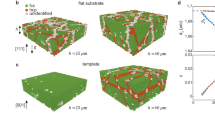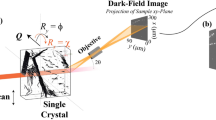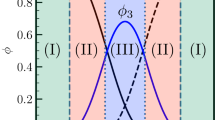Abstract
Mesoscale objects with unusual structural features may serve as the analogues of atoms in the design of larger-scale materials with novel optical, electronic or mechanical behaviour. In this paper we investigate the structural features and the equilibrium dynamics of micrometre-scale spherical crystals formed by polystyrene particles adsorbed on the surface of a spherical water droplet. The ground state of sufficiently large crystals possesses finite-length grain boundaries (scars). We determine the elastic response of the crystal by measuring single-particle diffusion, and quantify the fluctuations of individual dislocations about their equilibrium positions within a scar by determining the dislocation spring constants. We observe rapid dislocation glide with fluctuations over the barriers separating one local Peierls minimum from the next and rather weak binding of dislocations to their associated scars. The long-distance (renormalized) dislocation diffusion glide constant is extracted directly from the experimental data and is found to be moderately faster than single-particle diffusion. We are also able to determine the parameters of the Peierls potential induced by the underlying crystalline lattice.
This is a preview of subscription content, access via your institution
Access options
Subscribe to this journal
Receive 12 print issues and online access
$259.00 per year
only $21.58 per issue
Buy this article
- Purchase on SpringerLink
- Instant access to full article PDF
Prices may be subject to local taxes which are calculated during checkout




Similar content being viewed by others
References
Dinsmore, A. D. et al. Colloidosomes: Selectively permeable capsules composed of colloidal particles. Science 298, 1006–1009 (2002).
Jarrold, M. F. Chemistry: The smallest fullerene. Nature 407, 26–27 (2000).
Yao, Z., Postma, H. W. C., Balents, L. & Cekker, C. Carbon nanotube intramolecular junctions. Nature 402, 273–276 (1999).
Hirth, J. P. Theory of Dislocations (Wiley, New York, 1982).
Zahn, K., Lenke, R. & Maret, G. Two-stage melting of paramagnetic colloidal crystals in two dimensions. Phys. Rev. Lett. 82, 2721–2724 (1999).
Nelson, D. R. Defects and Geometry in Condensed Matter Physics (Cambridge Univ. Press, Cambridge, 2002).
Bowick, M. J., Nelson, D. R. & Travesset, A. Interacting topological defects on frozen topographies. Phys. Rev. B 62, 8738–8751 (2000).
Bausch, A. R. et al. Grain boundary scars and spherical crystallography. Science 299, 1716–1718 (2003).
Pertsinidis, A. & Ling, X. S. Diffusion of point defects in two-dimensional colloidal crystals. Nature 413, 147–150 (2001).
Pertsinidis, A. & Ling, X. S. Equilibrium configurations and energetics of point defects in two-dimensional colloidal crystals. Phys. Rev. Lett. 87, 098303 (2001).
Pickering, S. U. Note on the arsenates of lead and calcium. J. Chem. Soc. Trans. 91, 307–314 (1907).
Aveyard, R., Binks, B. P. & Clint, J. H. Emulsions stabilised solely by colloidal particles. Adv. Colloid Interface Sci. 100, 503–546 (2003).
Schilling, J., Sackmann, E. & Bausch, A. R. Digital imaging processing for biophysical applications. Rev. Sci. Instrum. 75, 2822–2827 (2004).
Delaunay, B. Sur la sphère vide. Bull. Acad. Sci. USSR 7, 793–800 (1934).
Dubreuil, F., Elsner, N. & Fery, A. Elastic properties of polyelectrolyte capsules studied by atomic-force microscopy and RICM. Eur. Phys. J. E 12, 215–221 (2003).
Weiss, J. A., Larsen, A. E. & Grier, D. G. Interactions, dynamics, and elasticity in charge-stabilized colloidal crystals. J. Chem. Phys. 109, 8659–8666 (1998).
Tarimala, S., Ranabothu, S. R., Vernetti, J. P. & Dai, L. L. Mobility and in situ aggregation of charged microparticles at oil-water interfaces. Langmuir 20, 5171–5173 (2004).
Scheidl, S. Mobility in a one-dimensional disorder potential. Z. Phys. B 97, 345–352 (1995).
Risken, H. The Fokker-Planck Equation (Springer, Berlin, 1984).
Bruinsma, R., Halperin, B. I. & Zippelius, A. Motion of defects and stress-relaxation in two-dimensional crystals. Phys. Rev. B 25, 579–604 (1982).
Acknowledgements
This work was supported by BA2029/5 and partly by the Fonds der Chemischen Industrie. The work of M.J.B. and J.H.M. was supported by the National Science Foundation through Grant No. DMR-0219292 (ITR). The work of D.R.N. was supported by the National Science Foundation through the Harvard Material Research Science and Engineering Laboratory through Grant No. DMR-0213805 and Grant No. DMR-0231631. We thank Jörg Schilling for the help he provided with imaging processing and Angelo Cacciuto and James McCullough for the Java Applets containing the triangulation routines. We are grateful for valuable discussions with Alex Travesset and M. Nikolaides.
Author information
Authors and Affiliations
Corresponding authors
Ethics declarations
Competing interests
The authors declare no competing financial interests.
Supplementary information
Supplementary Information
Supplementary movie file (AVI 1159 kb)
Rights and permissions
About this article
Cite this article
Lipowsky, P., Bowick, M., Meinke, J. et al. Direct visualization of dislocation dynamics in grain-boundary scars. Nature Mater 4, 407–411 (2005). https://doi.org/10.1038/nmat1376
Received:
Accepted:
Published:
Issue date:
DOI: https://doi.org/10.1038/nmat1376
This article is cited by
-
Role of dislocation elastic field on impurity segregation in Fe-based alloys
Scientific Reports (2021)
-
Morphology selection kinetics of crystallization in a sphere
Nature Physics (2021)
-
Additive manufacturing of ceramics and cermets: present status and future perspectives
Sādhanā (2021)
-
Transitions between phyllotactic lattice states in curved geometries
Scientific Reports (2020)
-
Crystallization of self-propelled particles on a spherical substrate
Applied Mathematics and Mechanics (2019)



